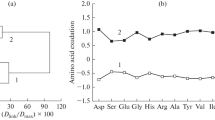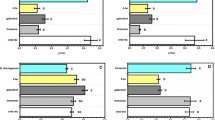Summary
The inclusion of exudates from the roots of peas and oats in liquid media has been found to increase the growth of micro-organisms isolated from both control soil and the rhizosphere of three-week old pea plants. In most cases the stimulation was greater for organisms from the rhizosphere than for those from outside this zone. For some organisms, yeast extract exhibited similar growth promoting properties as did pea root exudate, but for others the exudate stimulated growth in the presence of yeast extract. The root exudate could not be completely replaced by glucose, soil extract, vitamin-free casamino acids, or a synthetic mixture of known growth factors.
The effects of temperature treatment, acid and alkaline hydrolysis, extraction with chloroform, benzene, charcoal and alumina, and dialysis on the growth promoting activity of pea root exudate have also been studied.
Similar content being viewed by others
References
Bunt, J. S. and Rovira, A. D., Microbiological studies of some sub-antarctic soils. J. Soil Sci.6, 119 (1955).
Fries, N. and Forsman, B., Quantitative determination of certain nucleic acid derivatives in pea root exudate. Physiol. Plantarum4, 410 (1951).
Hendlin, D., The nutrition of microorganisms. Ann. Rev. Microbiol.8, 47 (1954).
Kline, L. and Barker, H. A., A new growth factor required byButyribacterium rettgeri. J. Bacteriol.60, 349 (1950).
Katznelson, H., Rouatt, J. W. and Payne, T. M., Liberation of amino acids by plants roots in relation to dessication. Nature174, 1110 (1954).
Lundegårdh, H. and Stenlid, G., On the exudation of nucleotides and flavonones from living roots. Ark. Botanik31 A, 1 (1944).
Meshkov, N. V. and Khodokova, R. N., The effect of root excretion of pea and maize on the development of some soil microorganisms when grown in a plant rhizosphere solution. Microbiologiya23, 544 (1954).
Omata, R. R., Studies on the nutritional requirements of the Fusobacteria I. An active principle present in yeast extract. J. Bacteriol.65, 326 (1953).
Peterson, W. H. and Peterson, M. S., Relation of bacteria to vitamins and other growth factors. Bacteriol. Revs.9, 49 (1945).
Porter, J. R., Bacterial chemistry and physiology. Publ.: John Wiley & Sons Inc. (1946).
Rovira, A. D., Plant root excretions in relation to the rhizosphere effect. I. The nature of root exudate from oats and peas. Plant and Soil7, 178–194 (1956).
West, P. M., Excretion of thiamin and biotin by the roots of higher plants. Nature144, 1050 (1939).
Author information
Authors and Affiliations
Rights and permissions
About this article
Cite this article
Rovira, A.D. Plant root excretions in relation to the rhizosphere effect. Plant Soil 7, 195–208 (1956). https://doi.org/10.1007/BF01343727
Received:
Issue Date:
DOI: https://doi.org/10.1007/BF01343727




